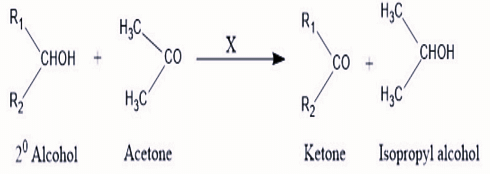Question:
Acetone can be converted to 2-methylpropan-2-ol using:
Acetone can be converted to 2-methylpropan-2-ol using:
Show Hint
Grignard reagents are excellent nucleophiles and are commonly used to add to carbonyl groups to form alcohols. The reaction with acetone results in the formation of a tertiary alcohol.
Updated On: Apr 25, 2025
- Grignard reagent
- Sodium hydride
- Hydrogen gas with Ni catalyst
- Sodium borohydride
Hide Solution
Verified By Collegedunia
The Correct Option is A
Solution and Explanation
Acetone (CH\(_3\)COCH\(_3\)) can be converted to 2-methylpropan-2-ol (tert-butyl alcohol) by reacting it with a Grignard reagent such as methyl magnesium bromide (CH\(_3\)MgBr). The Grignard reagent acts as a nucleophile and adds to the carbonyl carbon of acetone, resulting in the formation of a tertiary alcohol. - Sodium hydride (NaH) is a strong base used for deprotonation reactions, but it is not suitable for reducing acetone to a tertiary alcohol. - Hydrogen gas with Ni catalyst is typically used for hydrogenation reactions, but acetone does not undergo hydrogenation to form 2-methylpropan-2-ol. - Sodium borohydride (NaBH\(_4\)) is a mild reducing agent that reduces carbonyl compounds to alcohols, but it would not produce a tertiary alcohol from acetone. Therefore, the correct method is using a Grignard reagent to convert acetone to 2-methylpropan-2-ol.
Was this answer helpful?
0
0
Top Questions on carbonyl compounds
- Which of the following are neutral?
- KEAM - 2025
- Chemistry
- carbonyl compounds
- The correct stability order of carbocations is
- JEE Main - 2024
- Chemistry
- carbonyl compounds
- According to Oppenauer Oxidation reaction, oxidation of secondary alcohol to ketone by reagent (X) in acetone takes place, what is "X" :

- GPAT - 2024
- Organic Chemistry
- carbonyl compounds
- The Gattermann-Koch reaction is used in the industrial preparation of benzaldehyde. The electrophile involved in this reaction is
- CUET (UG) - 2024
- Chemistry
- carbonyl compounds
- In the following compounds, what is the increasing order of their reactivity towards nucleophilic addition reactions?
- CUET (UG) - 2024
- Chemistry
- carbonyl compounds
View More Questions
Questions Asked in KEAM exam
- A lift having mass 1000kg moves upward against a frictional force of 2000N. Power given by motor is 36000W. What is the velocity of the lift?
- KEAM - 2025
- Speed, Time and Distance
- Solve for \( a \) and \( b \) given the equations: \[ \sin x + \sin y = a, \quad \cos x + \cos y = b, \quad x + y = \frac{2\pi}{3} \]
- KEAM - 2025
- Trigonometry
- If \( A \) is a \( 3 \times 3 \) matrix and \( |B| = 3|A| \) and \( |A| = 5 \), then find \( \left| \frac{\text{adj} B}{|A|} \right| \).
- KEAM - 2025
- Matrix Operations
- An unbiased die is tossed until a sum \( S \) is obtained. If \( X \) denotes the number of times tossed, find the ratio \( \frac{P(X = 2)}{P(X = 5)} \).
- KEAM - 2025
- Probability
- If $ f(x) = \log 3 - \sin x $, $ y = f(f(x)) $, find $ y(0) $.
- KEAM - 2025
- Functions
View More Questions